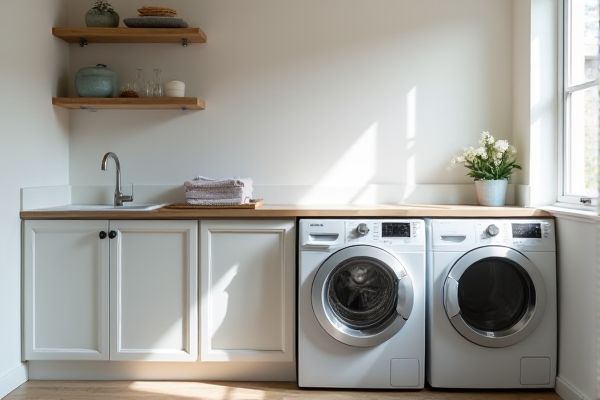
Choosing between a single sink and a double sink in your laundry room depends on your space, budget, and how you plan to use the area for tasks like soaking and rinsing clothes separately. Explore the benefits and drawbacks of each option to determine which setup best fits your laundry needs and enhances your workflow. Read on to discover the key differences and make an informed decision for your home.
Table of Comparison
| Feature | Single Sink | Double Sink |
|---|---|---|
| Functionality | One basin for washing and rinsing | Two separate basins for multitasking |
| Space Requirement | Smaller footprint, ideal for compact laundry rooms | Requires more space, suits larger laundry areas |
| Cost | Generally more affordable | Higher cost due to additional materials and installation |
| Cleaning Efficiency | Limited to one task at a time | Enables simultaneous washing and soaking/rinsing |
| Installation Complexity | Simple installation with one drain and faucet | More complex plumbing with two drains and faucets |
| Maintenance | Less maintenance, fewer parts | Requires more upkeep for two basins and faucets |
| Versatility | Basic laundry tasks | Greater flexibility for multi-step laundry processes |
Introduction: Choosing the Right Laundry Room Sink
Selecting the right laundry room sink depends on your space, laundry habits, and cleaning needs. Single sinks excel in smaller areas and handle basic tasks efficiently, while double sinks offer versatility for multitasking and soaking. Your choice influences both functionality and convenience in everyday laundry routines.
Overview of Single Sink Designs
Single sink designs in laundry rooms prioritize space efficiency and simplicity, typically featuring one basin that accommodates washing, soaking, and rinsing tasks. These sinks often measure between 18 to 24 inches in width, with deep basins ranging from 10 to 15 inches to handle larger laundry items and prevent splashing. Materials such as stainless steel, cast iron, or durable composite resins enhance durability and ease of maintenance in single sink configurations.
Overview of Double Sink Designs
Double sink designs in laundry rooms offer enhanced functionality by providing two separate basins for multitasking, such as soaking and rinsing clothes simultaneously. These designs often feature varied basin sizes or integrated accessories like built-in washboards and drying racks to maximize utility. Choosing a double sink can improve your laundry workflow and provide a more flexible and efficient cleaning space.
Space Requirements: Single vs Double Sink
A single sink in a laundry room requires less countertop and cabinet space, making it ideal for compact or narrow areas. In contrast, a double sink demands a wider countertop and additional plumbing, which can limit storage or workspace but offers greater functionality for multitasking. You should evaluate your available space and laundry needs to determine if a single sink's efficiency or a double sink's versatility suits your setup best.
Functionality and Practical Uses
A single sink in the laundry room offers simplicity and space-saving benefits, ideal for basic washing tasks and smaller laundry spaces. Double sinks provide enhanced functionality by allowing you to separate soaking, scrubbing, and rinsing, making it easier to manage multiple loads or hand-wash delicate items simultaneously. Choosing between a single or double sink depends on your laundry habits and space availability, with double sinks offering more versatility for multitasking.
Cost Comparison: Installation and Maintenance
Single sink laundry rooms generally have lower installation costs due to simpler plumbing requirements and fewer materials needed. Double sink setups increase upfront expenses with additional faucets, fixtures, and potential need for reinforced countertops or cabinetry. Maintenance for double sinks tends to be higher over time, as there are more components prone to leaks, clogs, or wear, whereas single sinks present fewer points of failure and easier access for repairs.
Pros and Cons of Single Sinks
Single sinks in laundry rooms offer ample space for washing large items and simplify plumbing installation, making them a cost-effective choice. However, their singular basin limits multitasking capabilities, such as soaking and rinsing simultaneously. Single sinks may also lead to slower workflow in busy laundry spaces compared to double sinks.
Pros and Cons of Double Sinks
Double sinks in a laundry room offer the advantage of multitasking, allowing you to soak clothes in one basin while washing or rinsing in the other, significantly improving efficiency. They can also separate delicate garments from heavily soiled items, preventing damage and cross-contamination. However, double sinks require more space, increased plumbing costs, and can consume more water, so your laundry room layout and utility budget should be carefully considered before installation.
Aesthetic Considerations and Style
Single sinks in laundry rooms offer a streamlined, minimalist aesthetic that complements modern, compact spaces, emphasizing clean lines and simplicity. Double sinks provide a more traditional or farmhouse style, often featuring larger basins and additional hardware that create a robust, functional look with added visual interest. Choosing between single and double sinks depends on desired design harmony, with single sinks enhancing sleek elegance and double sinks supporting a more classic, utilitarian charm.
How to Decide: Single or Double Sink for Your Laundry Room
Choosing between a single and double sink for your laundry room depends on your space availability and washing needs. A double sink offers versatility for multitasking, such as soaking and rinsing clothes separately, while a single sink maximizes space and is easier to clean. Consider how often you multitask and the size of your laundry area to determine which sink configuration best suits your workflow.
 homyna.com
homyna.com